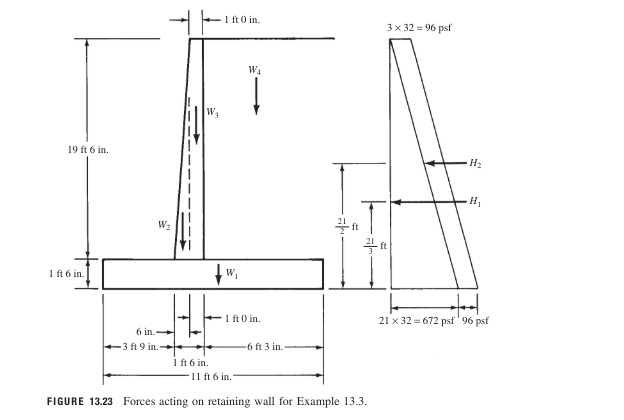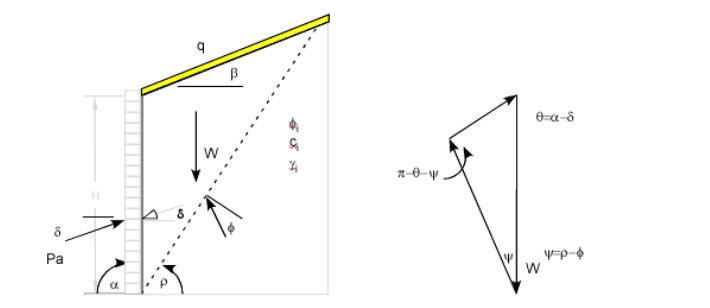Hello all, looking for some thoughts regarding applied soil weight & pressures in a retaining wall design.
I began designing reinforced concrete retaining walls from "Design of Reinforced Concrete" by Jack McCormac, which I was recommended by a peer of mine, and I've been following a similar set of calculations to the ones in his book since. I've put an image below of a figure from one of the textbook examples below:

Recently, I had a client contact me who was looking to use a segmental block retaining wall from Recon (for those unfamiliar: and their website included an analysis software that could be used when sizing their blocks. Looking through their documentation and running their software, I noticed that they were including the active soil pressure not just as a horizontal load, but also as a vertical force; thereby adding to their sliding and overturning resistance for the designed wall (see figure below from their websites documentation of their software).

I can see the potential merit in adding the weight of that soil as part of the wall system; it's just not something I ever gave consideration to and my prior design experiences (I don't believe I've seen EnerCALC account for something of the sort when I used it some time ago). It certainly seems more conservative to say the extra weight isn't there, but am I being too conservative in that assumption/leaving out a crucial part of my resisting force in this case? I mostly ask the question because this the wall in question is going to be roughly 12ft in uncovered height, and the Pa sliding/overturning resistance would make the difference between requiring a geogrid reinforcement or not. While it would be great to save my client the excavation cost, I'm also trying to be sure I'm not simply cherry-picking for extra resistance if its more common to be on the side of caution/conservativeness.
Any thoughts on the matter would be greatly appreciated.
I began designing reinforced concrete retaining walls from "Design of Reinforced Concrete" by Jack McCormac, which I was recommended by a peer of mine, and I've been following a similar set of calculations to the ones in his book since. I've put an image below of a figure from one of the textbook examples below:

Recently, I had a client contact me who was looking to use a segmental block retaining wall from Recon (for those unfamiliar: and their website included an analysis software that could be used when sizing their blocks. Looking through their documentation and running their software, I noticed that they were including the active soil pressure not just as a horizontal load, but also as a vertical force; thereby adding to their sliding and overturning resistance for the designed wall (see figure below from their websites documentation of their software).

I can see the potential merit in adding the weight of that soil as part of the wall system; it's just not something I ever gave consideration to and my prior design experiences (I don't believe I've seen EnerCALC account for something of the sort when I used it some time ago). It certainly seems more conservative to say the extra weight isn't there, but am I being too conservative in that assumption/leaving out a crucial part of my resisting force in this case? I mostly ask the question because this the wall in question is going to be roughly 12ft in uncovered height, and the Pa sliding/overturning resistance would make the difference between requiring a geogrid reinforcement or not. While it would be great to save my client the excavation cost, I'm also trying to be sure I'm not simply cherry-picking for extra resistance if its more common to be on the side of caution/conservativeness.
Any thoughts on the matter would be greatly appreciated.
